Owls are nocturnal and mostly solitary creatures, so many people don’t know that they are prevalent worldwide, except for a few remote islands and the coldest icecaps. There are more than 200 species of owls in total and 19 species of owls in the United States.
Owls are considered birds of prey, which means they are predatory birds that actively hunt other animals for food. Owls eat small mammals, small birds, fish, and insects. Birds of prey are also called raptors because they have excellent eyesight and strong feet with long talons to grasp prey. Raptors are also known for fast flight and a hooked beak for shredding meat. Most birds of prey prefer live prey, but some, like the vulture and condor, are scavengers.
In this article, we will discuss the 19 species of owls that live or visit the lower 48 states in the United States. Population data is collated by Partners in Flight for the USA and Canada combined.
1. Barn Owl

Barn owls live in grasslands, crop fields, and deserts.
©iStock.com/mzphoto11
Barn owls have a population of 120,000, which is steadily increasing. These owls live in grasslands, crop fields, and deserts. Barn owls have long legs and can reach through underbrush or snow to hunt. They have excellent vision and are very sensitive to sound. They can use sound alone to locate their prey! A barn owl’s diet consists of 90 percent rodents and other tiny mammals. They are also monogamous and stick with one partner for life.
2. Barred Owl

Barred owls are also called hoot owls or striped owls because of their unique feather pattern.
©Jim Cumming/Shutterstock.com
The barred owl has a population of 3,100,000, and its population is increasing. Barred owls are also called hoot owls or striped owls because of their unique feather pattern: striped tan and brown. They prefer to live in mature forests and are threatened by deforestation. These owls are territorial and mark their territory by standing on a tree branch near the boundary of their hunting area and singing. Their territory is usually static and is used by many generations of the same family.
3. Boreal Owl

Boreal owls prefer areas with dense coniferous trees, especially those in mountain ranges.
©WildMedia/Shutterstock.com
The population of boreal owls is 1,700,000, and they live in boreal forests (otherwise called snow forests). They prefer areas with dense coniferous trees, especially those in mountain ranges. Boreal owls are dark brown or rust-colored and hard to spot against a tree trunk. They eat small rodents like squirrels, gophers, moles, and shrews. The female boreal owl weighs twice as much as the male.
4. Burrowing Owl
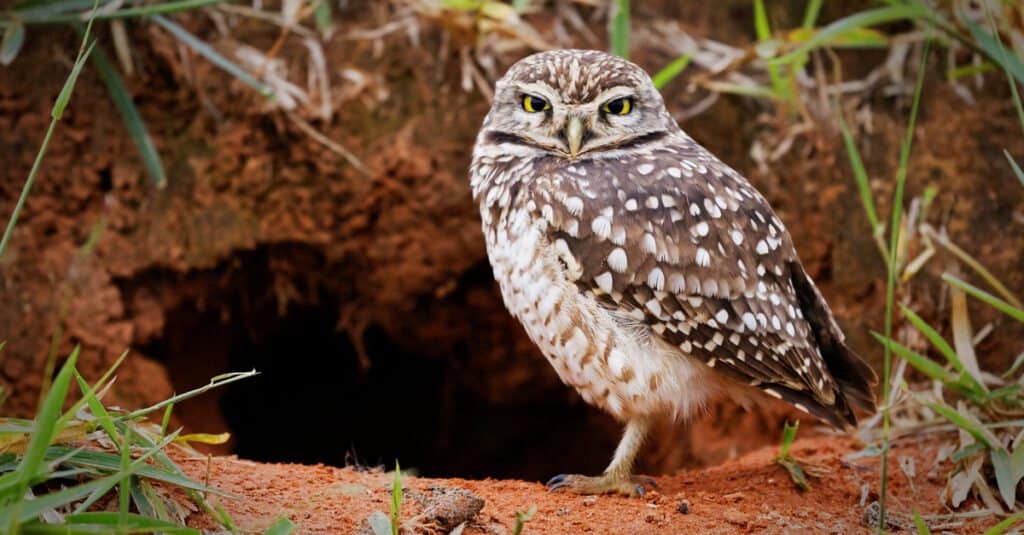
Burrowing owls are burrowing birds that live underground and hunt ground animals.
©Mauricio S Ferreira/Shutterstock.com
Burrowing owl populations are at 1,100,000 in the U.S. Their populations are in decline due to habitat loss, pesticides, and predators. As their name implies, they are burrowing birds that live underground and hunt ground animals. Unlike most owls, burrowing owls hunt during the day. They prefer a grassy meadow or other open areas for their home so they can easily spot prairie dogs, their favorite food. The main reason for their decline is North America’s prairie dog control programs, leaving the burrowing owl with nothing to eat. Burrowing owls are about the same size as American robins.
5. Eastern Screech Owl
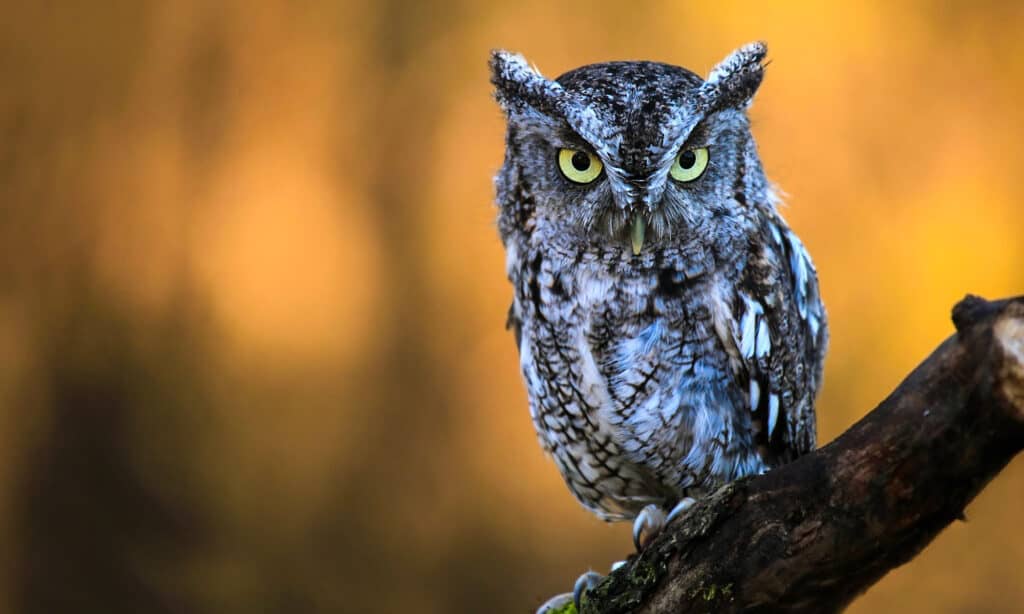
Eastern screech owls are nocturnal and spend the daylight hours in tree trunk cavities.
©mlorenz/Shutterstock.com
Eastern screech owls have a population of 680,000 in the U.S. and Canada. They have done an excellent job of adapting to living near artificial developments, but their numbers are declining because of deforestation. Their range in Eastern North America extends from Mexico to Canada and they favor deciduous or mixed woods and open areas with some large trees, including suburban yards. These owls are nocturnal and spend the daylight hours snuggled up in a tree trunk cavity. Strangely enough, their call does not sound like a screech but more like a horse‘s whinny. Eastern screech owls pick a mate and stay together for life.
6. Elf Owl
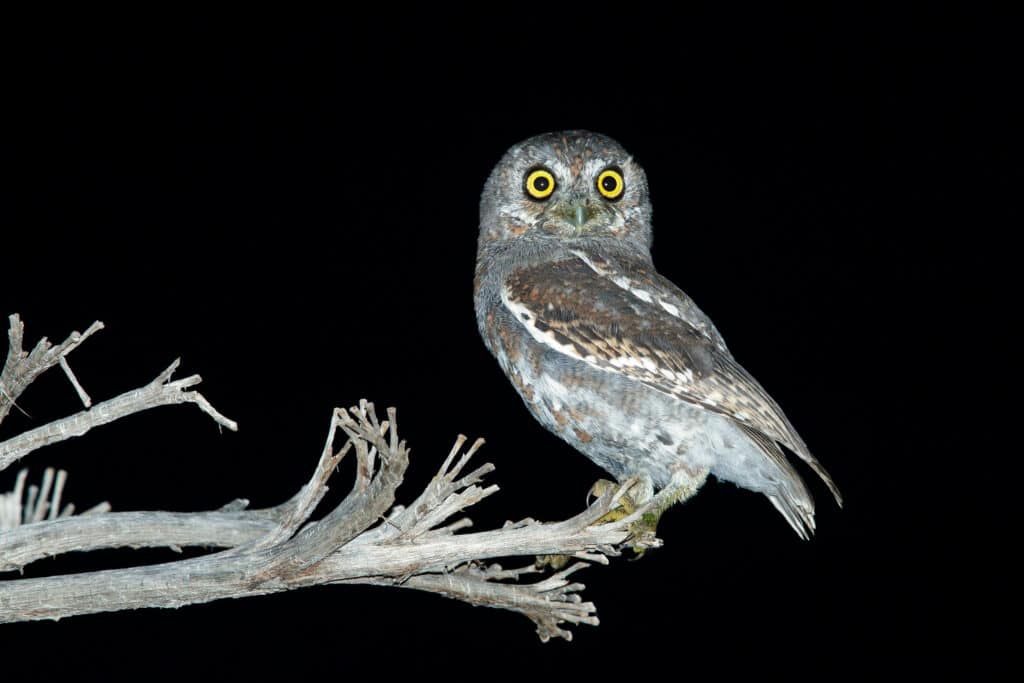
The elf owl is the world’s smallest owl.
©Agami Photo Agency/Shutterstock.com
The elf owl is the world’s smallest owl and weighs only 1.5 ounces! This owl is about the size of a sparrow. It has a wide range and lives mainly in the southwestern areas of the U.S. and Mexico. It prefers a desert area with scrub brush and trees and can often be found roosting in an old woodpecker hole inside a tree or cactus. The elf owls’ favorite food is insects, like crickets, scorpions, centipedes, and moths. The elf owl population is 40,000, and habitat loss in desert areas like California and Arizona has caused the species to become a threatened species.
7. Ferruginous Pygmy Owl
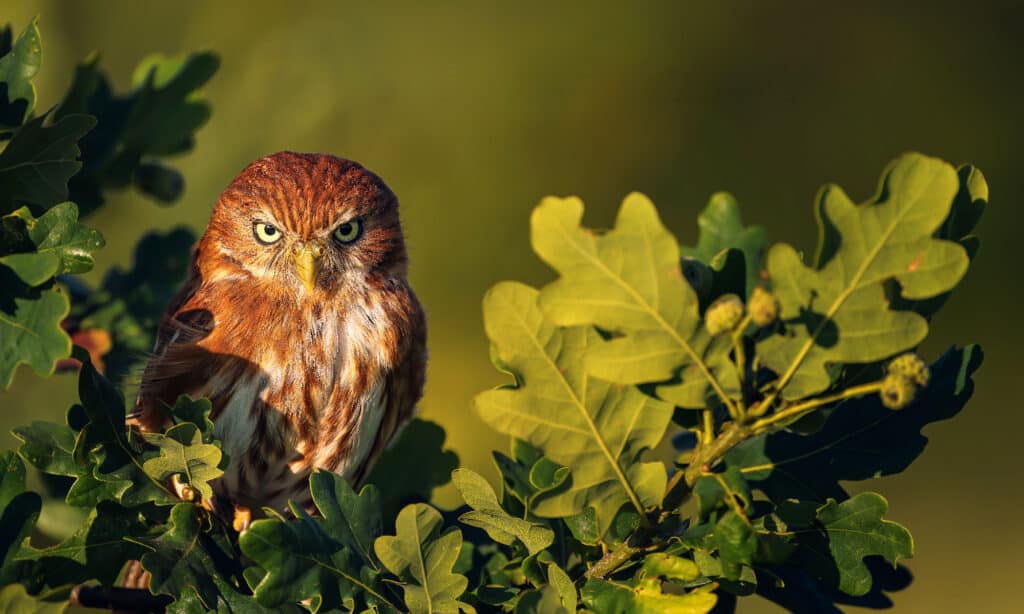
Ferruginous pygmy owls hunt during the day, and you will see them munching on lizards, amphibians, and reptiles.
©Jan Stria/Shutterstock.com
This owl lives in tropical dry forests and has a range that extends from southern Texas to Arizona. Fewer than 1,000 ferruginous pygmy owls are left due to habitat loss as their land is being converted into urban housing by humans. Ferruginous pygmy owls hunt during the day, and you will see them munching on lizards, amphibians, and reptiles. These tiny owls are only six inches tall and are brown with white streaks and light brown spots. They make the stereotypical hoot-hoot call for which owls are famous.
8. Flammulated Owl
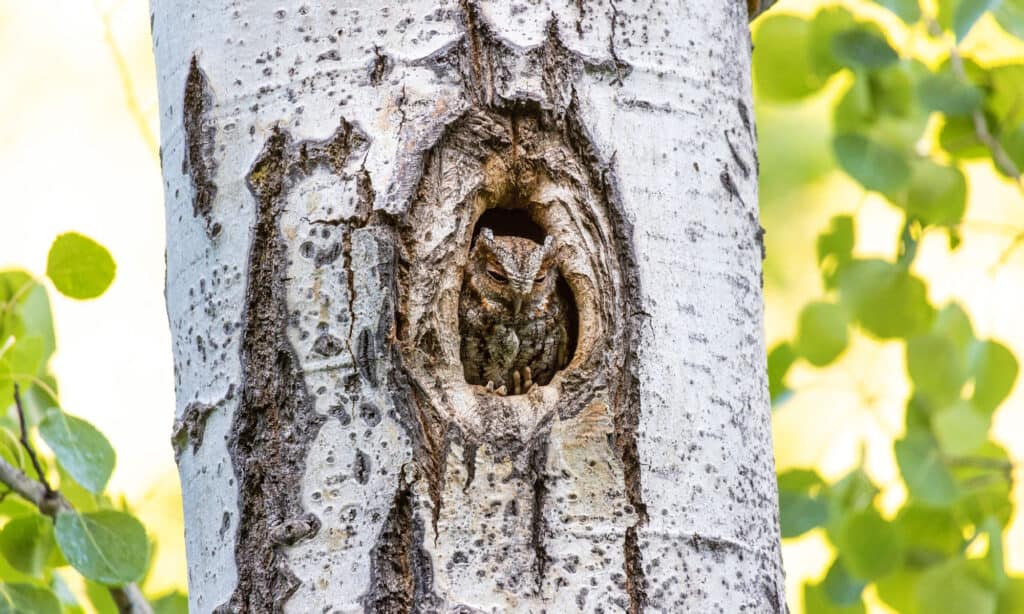
Flammulated owls nest in tree cavities and have up to four owlets at once.
©iStock.com/Devonyu
There are 11,000 flammulated owls left in the western forests of the U.S. and Canada. Their populations are steadily declining due to habitat loss and pesticide use. Flammulated owls are among the few that prefer insects to mammals for food, so pesticide use significantly impacts their survival. This small owl is rarely bigger than six inches tall but has an impressive 14-inch wingspan. Due to these large wings, they can fly very quickly. Flammulated owls nest in tree cavities and have up to four owlets at once.
9. Great Gray Owl
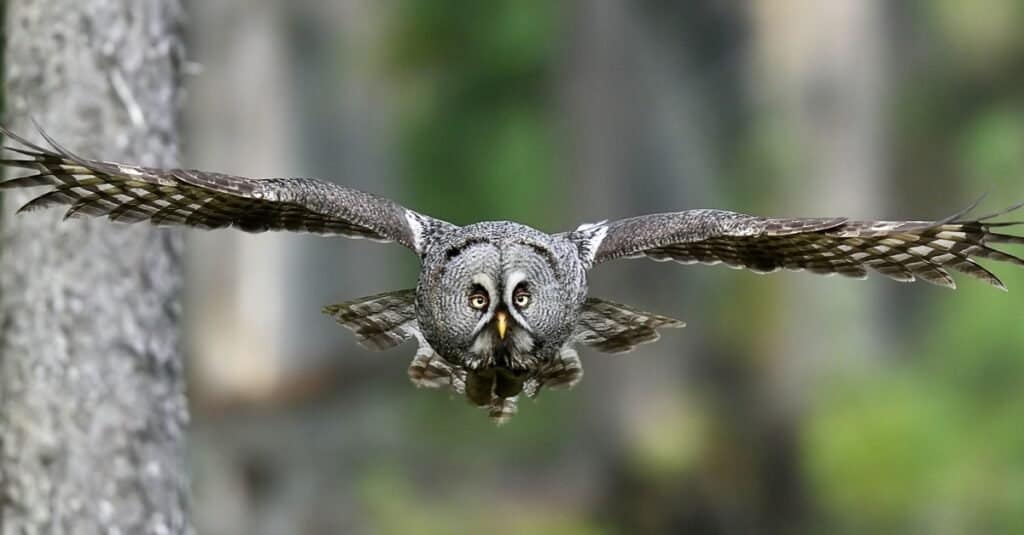
Great gray owls like to hunt by silently sitting on a stump or tree branch then swooping down to catch prey.
©Erik Mandre/Shutterstock.com
Great gray owls also live in boreal forests. Boreal forest refers to a vast area extending from the mid-latitude of North America to Eurasia. There are only 95,000 great gray owls left in the U.S. and Canada due to deforestation. Great gray owls like to hunt by silently sitting on a stump or tree branch only a couple of feet off the ground. They patiently listen and watch with their excellent vision and then swoop down to snatch their prey. Great gray owls have wingspans of more than five feet.
10. Great Horned Owl
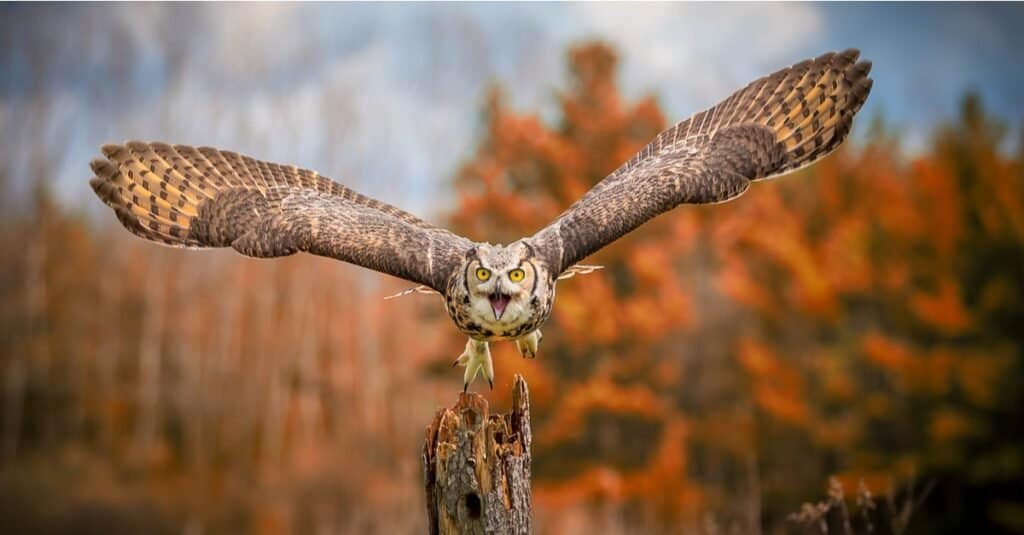
Great horned owls are threatened by pesticide poisoning and illegal hunting.
©Imran Ashraf/Shutterstock.com
The great horned owl population is 3,900,000 and is slowly declining. These owls have adapted to living in many environments but prefer a forest next to an open field for hunting. Their survival is threatened by pesticide poisoning and illegal hunting. Great horned owls are seriously fierce hunters and have been known to take down osprey, peregrine falcon, and even other owls.
11. Long-Eared Owl
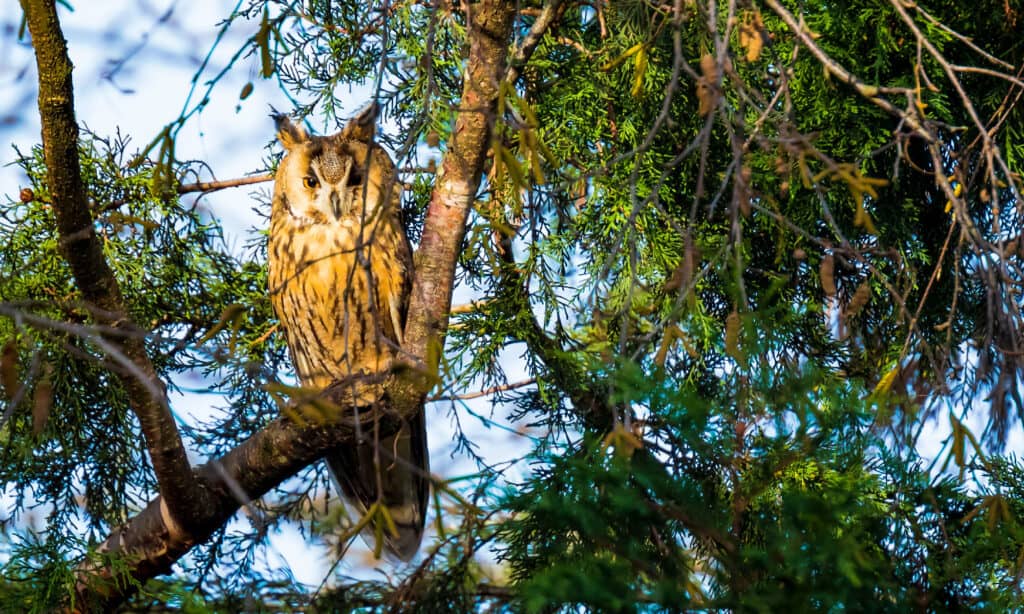
Long-eared owls are also called
tiger
owls because of their unusual brown and white striped pattern.
©SanderMeertinsPhotography/Shutterstock.com
Long-eared owls are one of the few owl species in the world who roost communally. The long-eared owl population in the U.S. and Canada is 140,000 and is on the decline. Deforestation has caused a 91 percent decline in their numbers since the 1970s. Their preferred habitat is woodlands and conifer groves with dense trees and open country for hunting for prey. These owls have long ears, which are actually tufted feathers that stay erect. Ornithologists’ leading theory is that long-eared owls use their ears to communicate their intentions and mood, much like a dog or cat.
12. Northern Hawk Owl
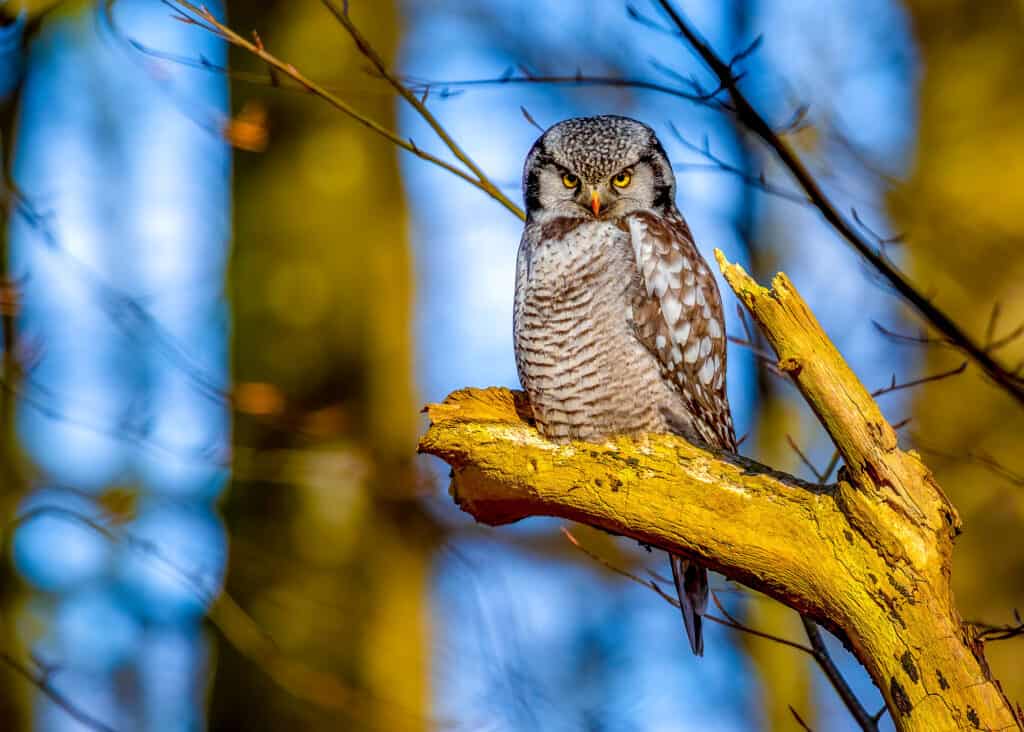
Northern hawk owls are threatened by deforestation.
©Svitlana Tkach/Shutterstock.com
Northern hawk owls number 100,000 and mainly inhabit boreal forests. They are threatened by deforestation, but their numbers have remained steady for the past few years. Northern hawk owls do not migrate and prefer to stay within the same breeding range for life. They are also not nocturnal and are only active during the day. You may be able to spot one in March when they are actively mating and building nests in hollow stumps; they especially like to nest in dead spruce trees. Northern hawk owls can spot prey over half a mile away.
13. Northern Pygmy Owl

Northern pygmy owls live in western forests and are threatened by habitat loss.
©Jordan Feeg/Shutterstock.com
There are 100,000 northern pygmy owls left, and their population looks stable. They live in western forests and are threatened by habitat loss, which removes their nesting trees. Because of their size and color (7 inches tall and grayish brown), they are hard to spot, most of the time, you will hear them calling from the top of the tallest tree around, but you won’t be able to find the bird. These owls are about the size of a house sparrow, but they hunt prey twice their size.
14. Northern Saw-Whet Owl
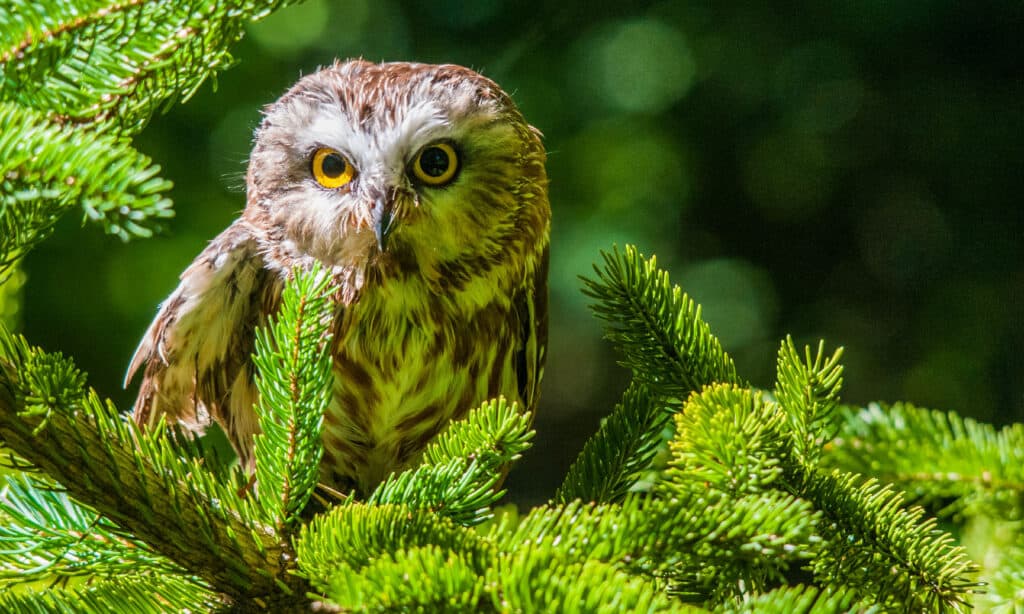
Northern saw-whet owls have sophisticated hearing due to their big ears and can precisely locate their prey.
©iStock.com/bookguy
The population of the northern saw-whet owl in the U.S. and Canada is 2,000,000, and their population is increasing. They have done a good job of adjusting to human habitation and have expanded their area to include a wide range of forests. They are named for a particular sound that they make that sounds like a saw blade being sharpened. Northern saw-whet owls have sophisticated hearing due to their big ears and can precisely locate their prey. They can even hunt in complete darkness.
15. Short-Eared Owl

Short eared owls are threatened by pesticide poisoning and habitat loss.
©iStock.com/Harry Collins
Short eared owls number 660,000 in the U.S. and Canada and are seeing a population decline. They are threatened by pesticide poisoning and habitat loss. Their numbers have declined by over 65 percent since the 1970s because of continued pesticide use by humans. You can probably spot a short-eared owl in your area because they live from coast to coast in the U.S. in prairies, marshes, tundra, and dunes, and hunt during the day. You will most easily spot them during mating season (March to April) when the male short-eared owl makes quite a spectacle of himself to attract a mate. The male dances and flaps his wings to seduce his partner, and once mated, they stay together for life.
16. Snowy Owl

Snowy owls are also known as polar owls, Arctic owls, and white owls.
©iStock.com/Pasforward
Snowy owls are also called polar owls, Arctic owls, and white owls due to their pure white feathers. There are only 30,000 snowy owls left in the U.S. and Canada, and they continue to decline. There are about 64% fewer snowy owls alive today than in 1970. This decrease is due to illegal hunting and climate change. As their name suggests, snowy owls spend the winter in southern Canada and the northern United States and prefer the arctic tundra as their home. Female snowy owls (who are white with specks of brown) are up to 28 inches in total length with a wingspan of over six feet.
17. Spotted Owl

Spotted owls live in old-growth western forests and are threatened by habitat loss.
©C.M.Corcoran/Shutterstock.com
There are only 15,000 spotted owls left in the U.S. and Canada. Despite being federally protected birds, deforestation negatively affects their population. They live in old-growth western forests and are threatened by habitat loss. Spotted owls are sit-and-wait predators because they patiently perch on a tree limb all night long, awaiting an unsuspecting squirrel, woodrat, or deer mouse to wander past.
18. Western Screech Owl

Deforestation threatens the population of western screech owls, leaving them with nowhere to nest or roost.
©Steve Bruckmann/Shutterstock.com
Western screech owls live in western forests along waterways. They often hunt animals that are twice their size. There are 220,000 western screen owls left in the U.S. and Canada. The loss of forests threatens them, leaving them nowhere to nest and roost. This type of screech owl does actually make a high-pitched screeching call. It also has calls that sound like barks, chuckles, trills, and whistles.
19. Whiskered Screech Owl

Whiskered screech owls are named for the whisker-like feathers along the sides of their facial disc.
©Amanda Guercio/Shutterstock.com
Whiskered screech owls are a threatened species, with under 500 left in the wild. They live in pine and oak forests in southern Arizona and New Mexico and continue through Mexico and Central America. Humans cut down their forests, and this habitat loss has nearly made the whiskered screech owl extinct. They are named for the whisker-like feathers along the sides of their facial disc. The whiskered screen owl makes a call that sounds like hoo hoo hoo!
Fun Facts About Owls
- Many species of owls have ears placed at different heights on the owl’s head. These asymmetrical ears help them find the location of prey very accurately.
- Owls have two toes that face forward and two toes that face backward. If they need to walk on their feet, they can turn one of their back toes to the front!
- Some types of owls swallow their prey whole.
- A group of owls is called a parliament of owls.
- Owl eyeballs are different from human eyeballs entirely. Owl eyes are shaped like tubes, similar to a pair of binoculars. This eye shape allows them to zoom in on prey from far away.
- Owls can turn their necks in a 270 rotation, but they cannot turn their eyes at all!
- Not all owls hoot — many hiss, whinny, screech, whistle, and bark.
- Owls have flattened faces (called facial discs) to magnify sound up to 10 times better than birds with round faces.
- Owls have three eyelids! One is for cleaning the eye, two is for blinking, and the third is for sleep.
- Many owls have fringed feathers that make them utterly silent while flying.
- Almost all female owls are larger-sized than male owls.
- Baby owls are called owlets.
- The oldest owl found in the fossil record (Orinmegalonyx oteroi) was three feet tall and lived 55 million years ago.
Summary of Types of Owls
Here’s a recap of the 19 interesting owl species that we took a look at.
| Number | Owl | Population | Habitat |
|---|---|---|---|
| 1 | Barn Owl | 120,000 | Grasslands, crop fields, deserts |
| 2 | Barred Owl | 3,100,000 | Mature forests |
| 3 | Boreal Owl | 1,700,000 | Boreal forests |
| 4 | Burrowing Owl | 1,100,000 | Grassy meadows or other open areas |
| 5 | Eastern Screech Owl | 680,000 | Deciduous or mixed woods |
| 6 | Elf Owl | 40,000 | Desert areas with scrub brush and trees |
| 7 | Ferruginous Pygmy Owl | Fewer than 1,000 | Tropical dry forests |
| 8 | Flammulated Owl | 11,000 | Western forests |
| 9 | Great Gray Owl | 95,000 | Boreal forests |
| 10 | Great Horned Owl | 3,900,000 | Forests next to open fields |
| 11 | Long-Eared Owl | 140,000 | Woodlands, conifer groves |
| 12 | Northern Hawk Owl | 100,000 | Boreal forests |
| 13 | Northern Pygmy Owl | 100,000 | Western forests |
| 14 | Northern Saw-Whet Owl | 2,000,000 | Wide range of forests |
| 15 | Short-Eared Owl | 660,000 | Prairies, marshes, tundra, dunes |
| 16 | Snowy Owl | 30,000 | Arctic tundra |
| 17 | Spotted Owl | 15,000 | Old-growth western forests |
| 18 | Western Screech Owl | 220,000 | Western forests along waterways |
| 19 | Whiskered Screech Owl | Fewer than 500 | Pine and oak forests |
The photo featured at the top of this post is © iStock.com/Philou73
Thank you for reading! Have some feedback for us? Contact the AZ Animals editorial team.






